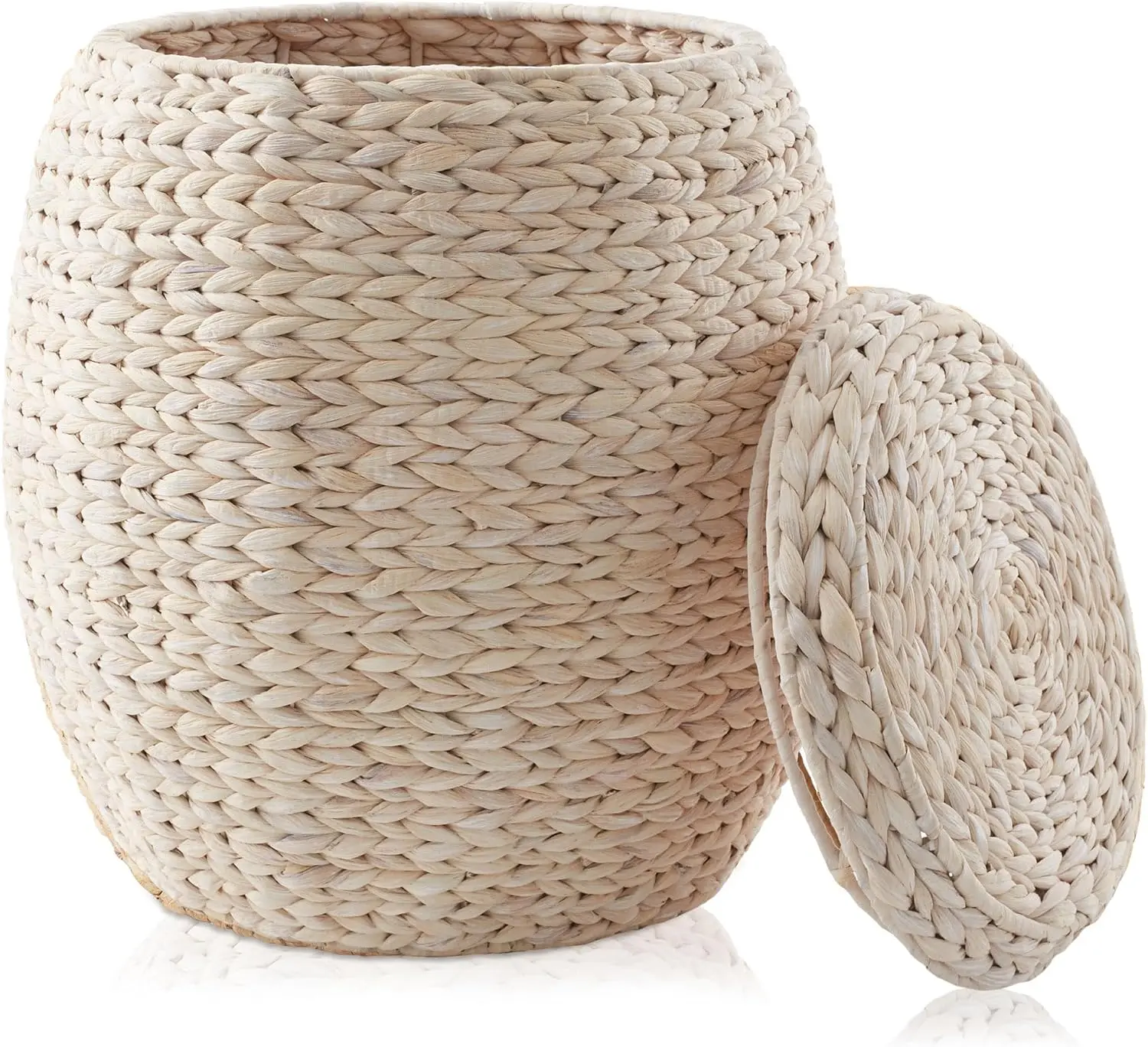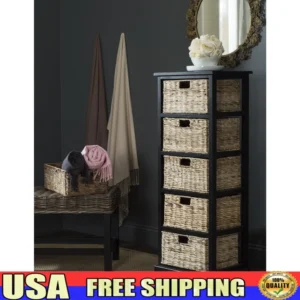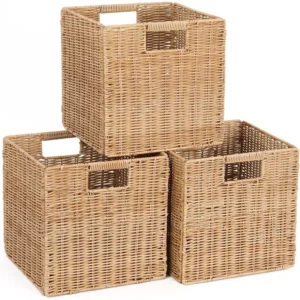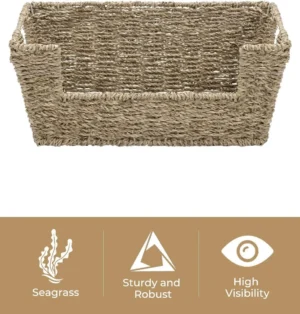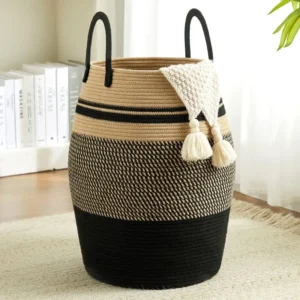1. Understanding the Mold Problem in Baskets
Mold is a type of fungus that grows in damp environments, and unfortunately, baskets are perfect targets for mold growth. This happens because many baskets are made from natural fibers like wicker, rattan, and seagrass, which are organic materials that mold can feed on. When these materials are exposed to moisture and limited airflow, mold spores can quickly take hold and begin to multiply.
There are several types of mold commonly found on baskets:
- Black mold: Dark in color and potentially toxic
- White mold: Appears as a powdery substance
- Green mold: Often found in particularly damp conditions
Mold thrives in specific conditions that many homes unknowingly provide. These include:
- Humidity levels above 60%
- Poor air circulation
- Dark storage spaces
- Warm temperatures
The health concerns associated with moldy baskets shouldn’t be overlooked. Mold can trigger allergic reactions, respiratory issues, and in some cases, expose household members to toxic compounds. What many people don’t realize is that mold can begin growing in as little as 24-48 hours when conditions are right, which is why addressing it quickly is essential.
Taking immediate action serves two important purposes: protecting your health and preserving your baskets. Comprehensive basket maintenance care is crucial for extending the life of these beautiful storage solutions, especially for natural fiber baskets that are particularly susceptible to mold damage.
2. Essential Supplies: Your Mold-Fighting Arsenal
Before tackling mold on your beloved baskets, gathering the right supplies is essential for effective and safe cleaning. Having these items ready before you start will make the process much more efficient.
| Supply Category | Specific Items | Purpose |
|---|---|---|
| Safety Equipment | N95 respirator mask, rubber gloves, safety goggles | Protects lungs, skin, and eyes from mold spores and cleaning chemicals |
| Natural Cleaning Agents | White vinegar, baking soda, hydrogen peroxide (3%) | Effective natural options for killing mold and removing stains |
| Chemical Options | Diluted bleach (1:10 with water), commercial mold removers | Stronger solutions for stubborn mold (use only when necessary) |
| Cleaning Tools | Soft-bristle toothbrush, spray bottles, microfiber cloths, soft brushes | Allows for gentle but thorough cleaning of basket weaves |
| Drying Equipment | Clean dry towels, fans | Essential for thoroughly drying baskets after cleaning |
The type of cleaning agent you choose will largely depend on the basket material and the severity of mold growth. For most natural fiber baskets, gentler options like vinegar solutions (1:1 white vinegar to water) are ideal for preserving the integrity of the material while still effectively removing mold.
For baskets with intricate weaves, soft-bristle toothbrushes are particularly useful for getting into tight spaces without damaging the fibers. If you’re dealing with extensive mold damage and considering replacement instead, exploring our wicker basket collection might provide suitable alternatives that match your home décor.
Remember that proper tools not only make the cleaning process more effective but also help protect your baskets from damage during the mold removal process.
3. Safety First: Protecting Yourself While Cleaning Moldy Baskets
When tackling mold on your baskets, your health should be the priority. Mold spores can cause respiratory issues and allergic reactions when disturbed, making proper protection essential.
Choose a well-ventilated area: Always clean moldy baskets outdoors or in areas with plenty of airflow, such as near open windows or under a fan.
Wear appropriate protective gear: Put on your N95 respirator mask (not just a regular dust mask), rubber gloves, and protective eyewear before handling moldy items.
Ensure proper mask fit: Make sure your respirator forms a tight seal around your nose and mouth to prevent spores from being inhaled.
Handle cleaning agents carefully: Keep all cleaning solutions away from children and pets, and always read product labels for safety instructions.
Prevent cross-contamination: Don’t carry moldy baskets through clean areas of your home without covering them first, and wash your hands thoroughly after handling.
WARNING: Never mix bleach with ammonia, vinegar, or other cleaning agents. This can create toxic chloramine gas that causes serious respiratory distress and can be fatal.
Consider reaching out for professional help if you have severe allergies, asthma, or other respiratory conditions that could be aggravated by mold exposure. Additionally, extensive mold infestations that cover large areas may require professional remediation rather than DIY cleaning.
Following CDC guidelines for mold cleanup is always recommended, especially when dealing with larger mold problems. For those concerned about chemical exposure, exploring non-toxic basket cleaning solutions can provide safer alternatives while still effectively addressing mold issues.
4. Pre-Cleaning Assessment: Evaluating Your Basket
Before diving into the cleaning process, taking time to evaluate your basket’s condition will help determine the best approach and whether the basket is worth saving.
Basket Salvageability Checklist:
- Is the basket structurally sound, or is it falling apart?
- Has the mold caused visible deterioration of the fibers?
- Does the basket have sentimental or monetary value worth the cleaning effort?
- Is the mold only on the surface, or has it penetrated deep into the material?
- Does the basket have a strong, persistent musty odor even when dry?
The extent of mold growth is a critical factor in your assessment. Surface mold appears as spots or a thin layer that hasn’t visibly damaged the basket material. This type of mold infestation is typically salvageable. However, if you notice the fibers breaking down, changing color throughout, or becoming soft and mushy, the mold has likely penetrated deeply.
Different basket materials require different cleaning approaches. While plastic baskets can withstand more aggressive cleaning methods, antique or delicate woven baskets need gentler care. The type of basket also affects your organizing laundry wicker baskets strategy, as some organizational methods may create conditions that encourage mold growth.
If your basket shows signs of extensive damage—such as crumbling fibers, structural weakness, or deep mold penetration—it may be more practical to replace it rather than attempt cleaning. This is especially true if the basket will be used for storing items that could be contaminated by residual mold spores, such as clean laundry or food items.
5. Step-by-Step Mold Removal Process: Basic Technique
Once you’ve determined your basket is worth saving, follow this methodical approach to safely and effectively remove mold.
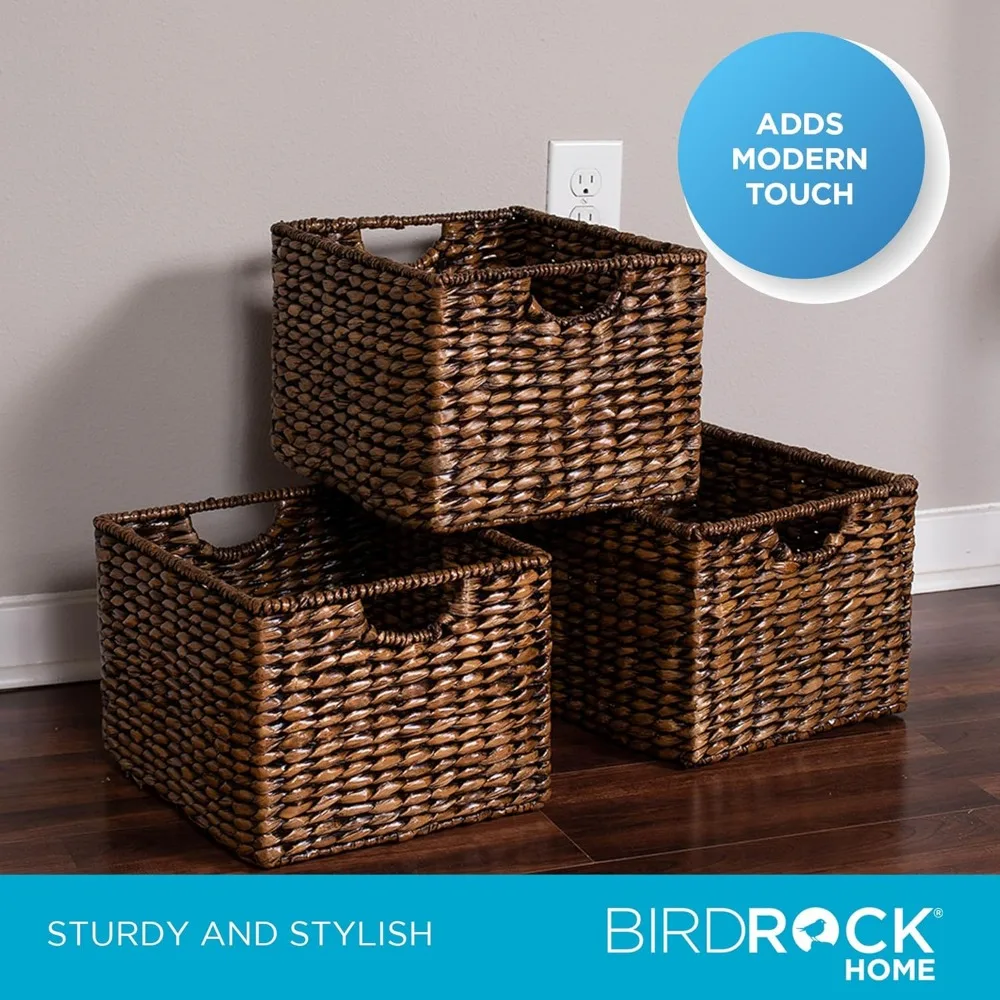
Take it outside: Move the basket outdoors to prevent mold spores from spreading throughout your home. If outdoor cleaning isn’t possible, choose a well-ventilated bathroom or utility area.
Remove loose mold: Using a soft brush or vacuum with a HEPA filter, gently remove loose mold spores from the basket surface. Always brush away from your body to avoid inhaling spores.
Prepare your cleaning solution: For most baskets, a 1:1 solution of white vinegar and water works well. Pour this into a spray bottle for easy application.
Apply the solution: Lightly spray the moldy areas, being careful not to oversaturate the basket. For tightly woven baskets, use a cloth dampened with the solution instead of spraying directly.
Scrub gently: Using a soft-bristled brush, scrub in the direction of the weave pattern. For tight weaves, use circular motions with a toothbrush. Work from top to bottom to prevent dripping onto uncleaned areas.
Tip: Test your cleaning solution on an inconspicuous area first to ensure it doesn’t damage or discolor the material.
Address tight spots: For areas where the weave is particularly tight or in corners, use a cotton swab dipped in the cleaning solution.
Rinse if necessary: For water-safe baskets, lightly spray with clean water to remove cleaning solution residue. Skip this step for baskets that shouldn’t get too wet.
Begin drying immediately: Use clean, dry towels to absorb excess moisture, then position the basket for optimal air circulation.
Complete drying: Allow the basket to dry thoroughly for 24-48 hours minimum. The basket should feel completely dry to the touch with no cool or damp spots.
This basic technique works well for most baskets, but you may need to adjust your approach based on your specific basket material. For baskets that are heavily used in daily life, like those in your laundry room, consider exploring our selection of woven laundry baskets that feature designs with better air circulation to prevent future mold issues.
6. Material-Specific Cleaning Methods: Tailored Approaches
Different basket materials require specific cleaning approaches to effectively remove mold while preserving the integrity of the basket.
Wicker and Rattan Baskets
- Use a 1:1 vinegar-water solution applied with minimal moisture
- Allow longer drying time (minimum 48 hours) due to porous nature
- Avoid full submersion in water as it can weaken the structure
- Use soft brushes to clean between weaves without damaging fibers
- Consider light exposure to sunshine after cleaning (maximum 1-2 hours)
Fabric or Cloth Baskets
- Check manufacturer’s tags for washing instructions
- Machine-washable fabric baskets: Use hot water and mild detergent
- Non-washable fabric baskets: Spot clean with hydrogen peroxide
- Always ensure complete drying before using again
- Consider replacing fabric liners rather than cleaning if heavily molded
Plastic Baskets
- Can withstand more thorough cleaning methods
- Use stronger solutions like diluted bleach (1:10 with water)
- Scrub with more vigorous pressure using a stiff brush
- Rinse thoroughly to remove all cleaning solution
- Dry completely even though the material isn’t absorbent
Wooden Baskets
- Use minimal moisture with a nearly-dry cloth
- Apply cleaning solution to the cloth, not directly to the basket
- Work quickly to avoid prolonged moisture exposure
- Never soak or submerge wooden components
- Consider wood-safe oils after complete drying to restore finish
Specialty or Antique Baskets
- Test all solutions on an inconspicuous area first
- Use the gentlest effective method available
- Consider consulting a professional restorer
- Use cotton swabs for precision cleaning of detailed areas
- Prioritize air drying in a climate-controlled environment
Rattan baskets require particularly careful handling due to their natural fiber composition. When cleaning these types of baskets, remember that the material can become brittle if exposed to harsh chemicals or excessive moisture. The intricate weaving patterns also make thorough drying critically important to prevent mold from recurring in hard-to-see inner fibers.
7. Vinegar Method: Natural Mold Elimination
White vinegar is one of the most effective natural mold fighters, killing approximately 80% of mold species thanks to its acetic acid content. This makes it an excellent first choice for treating moldy baskets, especially those made from natural fibers.
The vinegar method works by creating an acidic environment that mold cannot survive in. It penetrates porous surfaces to kill mold at its roots, not just on the surface. This is particularly important for woven baskets where mold can grow deep within the fibers.
To effectively use vinegar for mold removal:
Create a solution of equal parts white vinegar and water (1:1 ratio) in a spray bottle. For delicate or antique baskets, dilute further to a 1:2 ratio (one part vinegar to two parts water).
Spray the solution lightly onto moldy areas, or apply with a cloth for more controlled application. Be careful not to oversaturate the material.
Allow the solution to sit for 1 hour to penetrate and kill the mold spores.
Gently scrub the area with a soft brush, following the direction of the weave whenever possible.
Use a dry cloth to remove excess moisture immediately after cleaning.
Many people worry about the strong vinegar smell, but this odor naturally dissipates as the vinegar dries. To speed up this process, you can wipe the basket with a cloth dampened with plain water after cleaning. Adding a few drops of essential oil like lavender or tea tree oil (which has its own anti-fungal properties) to your vinegar solution can also help mask the smell while providing additional mold-fighting benefits.
Proper wicker laundry basket storage ideas often emphasize keeping baskets in well-ventilated areas after cleaning, which is particularly important after using the vinegar method to ensure complete drying and odor dissipation.
8. Baking Soda Technique: Gentle Abrasive Cleaning
Baking soda provides a gentle yet effective way to remove mold from baskets. Its mild abrasive quality helps scrub away mold while its alkaline nature helps inhibit further mold growth. This method is particularly useful for baskets with visible mold stains that need a bit more scrubbing power than vinegar alone can provide.
To create an effective baking soda solution:
Mix 2 tablespoons of baking soda with 1/4 cup of water to form a paste.
For stubborn mold, create a thicker paste using less water.
Apply the paste directly to moldy areas using a soft cloth or brush.
Let the paste sit for 15-20 minutes to help break down the mold.
Gently scrub the area with a soft-bristled brush, working the paste into the weave.
Wipe away residue with a damp cloth, being careful not to saturate the basket.
For an enhanced cleaning effect, you can combine the baking soda and vinegar methods:
First spray the moldy area with the vinegar solution.
Immediately sprinkle baking soda over the vinegar-dampened area.
The mixture will fizz, helping to lift mold from the fibers.
After the fizzing stops (about 5-10 minutes), gently scrub and wipe clean.
Troubleshooting tips:
- If the paste is too runny, add more baking soda until you achieve a toothpaste-like consistency.
- For baskets with tight weaves, use a toothbrush to work the paste into crevices.
- If residue remains after cleaning, lightly mist with water and wipe again.
Remember that while the baking soda technique is gentler than chemical cleaners, it’s still important to test it on an inconspicuous area of your basket first, especially for dyed or painted baskets where the mild abrasion might affect the finish.
9. The Critical Drying Process: Preventing Mold Recurrence
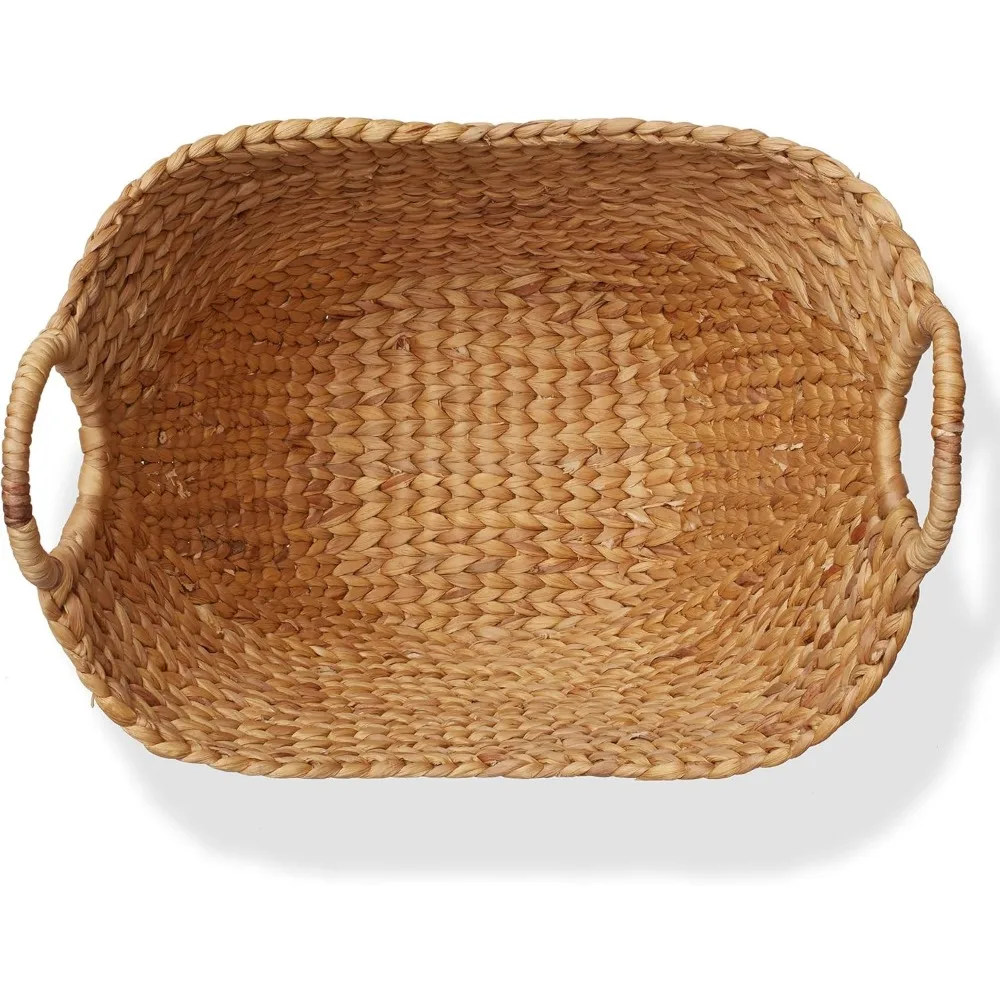
The most crucial step in preventing mold from returning to your baskets is ensuring they dry completely after cleaning. Even trace amounts of moisture left behind can restart the mold cycle within days.
Optimal Drying Methods by Basket Type
- Wicker and rattan baskets: Require minimum 48 hours drying time due to their porous nature
- Plastic baskets: Need thorough drying of crevices and bottoms where water collects
- Fabric baskets: May require multiple position changes during drying to ensure all areas dry
- Wooden baskets: Should be dried promptly and completely to prevent warping
Best Practices for Effective Drying
- Position baskets for maximum airflow through and around the weave
- Elevate baskets on a drying rack to allow air circulation underneath
- Use fans to increase air movement around the basket
- Rotate baskets periodically to ensure even drying
- Avoid direct sunlight which can damage natural fibers, opt for indirect light
- Use a dehumidifier in the drying area if your home has high humidity
Common Drying Mistakes to Avoid
- Stacking baskets before they’re completely dry
- Placing baskets against walls where air can’t circulate
- Returning items to baskets before they’re 100% dry
- Assuming surface dryness means the entire basket is dry
- Drying in humid areas like bathrooms or basements
Testing for Complete Dryness
To ensure your basket is truly dry, check for coolness to the touch (which indicates remaining moisture), feel for flexibility changes in the material, and inspect the bottom and inner crevices where moisture lingers longest. Remember that in optimal conditions (40-60% humidity with good air circulation), most baskets still need at least 24 hours to dry completely.
For ongoing storage, consider selecting woven storage baskets with designs that promote better air circulation, which naturally reduces the risk of moisture accumulation and mold growth over time.
10. Stubborn Mold: Advanced Removal Techniques
When basic cleaning methods fail to remove persistent mold, it’s time to consider stronger approaches. However, these should be used carefully as they may damage certain basket materials.
Hydrogen Peroxide Method
For stubborn mold that resists vinegar treatment:
* Use 3% hydrogen peroxide (standard drugstore strength)
* Apply undiluted to tough spots or dilute 1:1 with water for general cleaning
* Spray directly on moldy areas and let sit for 10-15 minutes
* Scrub gently with a soft brush
* Wipe clean and dry thoroughly
Oxygen Bleach Solution
Safer than chlorine bleach for natural fibers:
* Dissolve 1 tablespoon oxygen bleach (like OxiClean) in 1 cup warm water
* Test on an inconspicuous area first
* Apply to moldy areas with a spray bottle or cloth
* Allow to work for 15-20 minutes
* Rinse thoroughly and dry completely
Diluted Bleach (Last Resort)
Only for white or colorfast baskets that won’t be damaged:
* Mix a 1:10 solution of bleach to water
* Apply with a cloth rather than spraying to control application
* Let sit for no more than 5 minutes
* Rinse extremely well to remove all bleach residue
* Dry immediately and thoroughly
Multiple Treatment Approach
For deeply embedded mold:
* Begin with a vinegar treatment
* Allow to dry completely (24 hours)
* Follow with hydrogen peroxide treatment
* Allow to dry again completely
* Repeat if necessary, allowing full drying between treatments
If your basket still shows signs of mold after multiple treatment attempts, or if the basket has begun to deteriorate, it may be time to consider replacement. The question of are wicker baskets good for laundry depends partly on your ability to keep them dry and mold-free, so proper maintenance is essential for their longevity.
Remember that baskets used for food storage or children’s toys should be replaced rather than intensively treated if mold persists, as health concerns outweigh restoration efforts in these cases.
11. Prevention Strategies: Keeping Mold Away for Good
After putting in the effort to clean your baskets, implementing proper prevention strategies will help ensure mold doesn’t return. These simple habits can make a significant difference in keeping your baskets mold-free.
Humidity Control
- Maintain home humidity levels between 30-50%
- Use dehumidifiers in naturally damp areas
- Place moisture-absorbing products like silica gel packets in storage areas
- Monitor humidity with an inexpensive humidity gauge
Strategic Storage Placement
- Store baskets in well-ventilated areas with good air circulation
- Keep baskets away from exterior walls that may get damp
- Elevate baskets slightly off basement floors using shelving
- Avoid storing in naturally humid spaces like bathrooms or basements
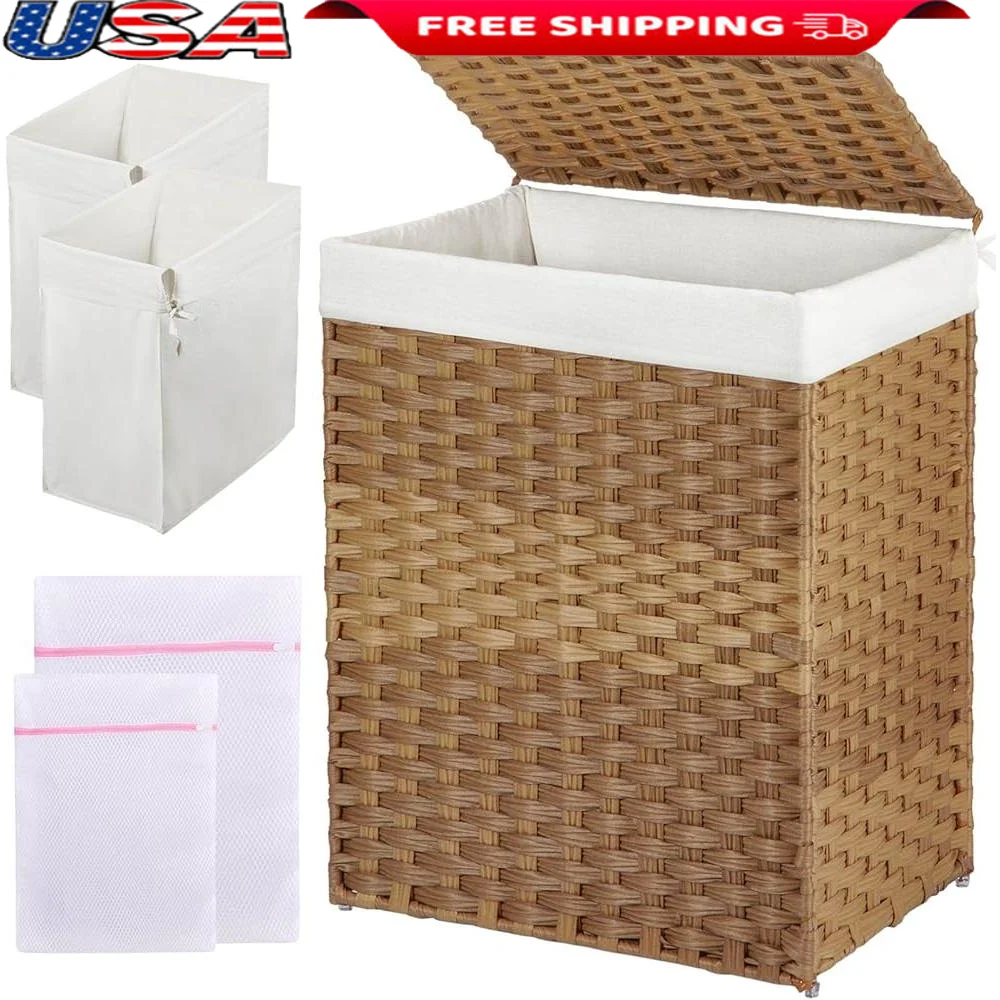
Moisture Barriers and Liners
- Use removable fabric liners in baskets that hold damp items
- Wash liners regularly and ensure they’re completely dry before replacing
- Consider plastic or waterproof liners for baskets in humid areas
- Place a moisture barrier (like a plastic sheet) under baskets in problem areas
Regular Maintenance
- Inspect baskets monthly for early signs of mold or mildew
- Remove and clean baskets at the first sign of musty odors
- Periodically empty and air out baskets, especially those in closets
- Give baskets brief sun exposure (15-30 minutes) every few months
Effortless laundry organization with wicker baskets can be maintained long-term by incorporating these preventative measures into your routine. Using breathable liners in laundry baskets is particularly important since they frequently come in contact with damp clothing.
Black Wicker Baskets, Rattan Storage Baskets, Tall Wicker Baskets, Wicker Shelf Baskets, Woven Storage Baskets
5-Tier Distressed Black Wood Frame Storage Tower with Removable Wicker Baskets for Home Organization$715.80 Select options This product has multiple variants. The options may be chosen on the product pageWicker Laundry Baskets, Woven Laundry Baskets, Woven Storage Baskets
$392.02 Select options This product has multiple variants. The options may be chosen on the product pageRattan Shelf Baskets, Rattan Storage Baskets, Small Wicker Baskets, Square Wicker Baskets
Square Plastic Wicker Storage Baskets Set of 3 with Collapsible Design for Cube Storage Organization$185.47 Select options This product has multiple variants. The options may be chosen on the product pageWicker Baskets with Handles, Wicker Storage Baskets, Woven Storage Baskets
$137.92 Select options This product has multiple variants. The options may be chosen on the product pageLarge Wicker Laundry Baskets, Tall Wicker Baskets, Woven Laundry Hampers, Woven Storage Baskets
$130.54 Select options This product has multiple variants. The options may be chosen on the product pageWoven Laundry Baskets, Woven Laundry Washing Baskets
Price range: $136.76 through $581.37 Select options This product has multiple variants. The options may be chosen on the product page
For areas where humidity control is challenging, consider rotating your basket use to allow each basket to fully air out periodically. This simple practice can significantly extend the life of your beautiful storage solutions and keep them looking their best for years to come.
12. When to Replace Your Basket: Signs It’s Beyond Saving
Sometimes, despite your best efforts, a basket may be too far gone to salvage. Knowing when to say goodbye can save you time, effort, and potential health concerns.
Signs Your Basket Should Be Replaced:
- Structural damage: Breaking, cracking, or unraveling weaves that compromise the basket’s integrity
- Deep mold penetration: Discoloration that remains after multiple cleaning attempts
- Softening of fibers: Previously firm materials that have become soft, brittle, or mushy
- Persistent odor: Musty smell that remains after thorough cleaning and drying
- Visible deterioration: Fibers that fall apart when gently touched or brushed
- Repeated mold return: Baskets that develop mold quickly after cleaning, despite preventive measures
When evaluating whether to keep or replace a moldy basket, consider its purpose as well. Baskets used for food storage, children’s toys, or clean laundry should meet higher standards of cleanliness than decorative baskets or those used for storing non-sensitive items.
From a sustainability perspective, natural fiber baskets that are beyond saving can often be composted rather than sent to a landfill. Remove any non-biodegradable elements like plastic handles first.
If you need to replace your baskets, consider exploring our collection of wicker laundry baskets designed with features that help prevent moisture buildup and resist mold growth. Look for options with improved ventilation, removable liners, or materials treated with natural mold inhibitors for longer-lasting performance.
13. Can You Prevent Mold in High-Humidity Environments?
High-humidity areas like bathrooms, kitchens, and basements present special challenges for basket storage. However, with some extra precautions, you can still enjoy beautiful basket storage in these spaces.
Bathroom Baskets
Q: Can I use baskets in my bathroom without getting mold?
A: Yes, but choose your baskets carefully. Opt for more water-resistant materials like seagrass, plastic, or marine rope rather than untreated wicker. Always use removable liners that can be frequently washed, and ensure baskets are elevated off the floor to avoid contact with water splashes.
Kitchen Solutions
Q: How can I prevent mold on baskets that store fruits and vegetables?
A: Line fruit baskets with paper towels that can be changed regularly, and avoid putting damp produce directly in baskets. Clean these baskets weekly with vinegar solution, and allow fruits and vegetables to fully dry before storing them. Consider plastic-coated wire baskets that provide better airflow and are easier to clean.
Basement Storage
Q: Are there special considerations for basement basket storage?
A: Absolutely. Use small dehumidifiers or moisture absorbers in basement storage areas. Place moisture barriers (like plastic sheets) underneath baskets, and check baskets monthly for early signs of mold. Opt for synthetic materials rather than natural fibers when possible for basement storage.
For any high-humidity environment, increasing air circulation is key. Small fans, regular rotation of items, and leaving space between baskets can make a significant difference. Silica gel packets placed discreetly in or under baskets can also help absorb excess moisture in enclosed spaces.
14. Are Natural Mold Inhibitors Effective for Baskets?
Natural mold inhibitors offer an eco-friendly approach to keeping your baskets mold-free. While generally less potent than chemical alternatives, they can be effective as preventative measures, especially for baskets that have been thoroughly cleaned.
Natural Mold Inhibitors Worth Trying
Tea Tree Oil
* Add 5-10 drops to 1 cup of water in a spray bottle
* Lightly mist baskets monthly (test on inconspicuous area first)
* Offers antimicrobial properties that combat mold growth
* Strong scent that dissipates after a few days
Grapefruit Seed Extract
* Mix 15-20 drops in 2 cups of water
* Less aromatic than tea tree oil
* Apply with a cloth to avoid over-wetting baskets
* Effective against a wide range of mold species
White Vinegar as Preventative
* Dilute 1:4 with water for maintenance spraying
* Apply every 1-2 months as preventative treatment
* Virtually no residual scent after drying
Pros of Natural Inhibitors:
* Non-toxic and environmentally friendly
* Safe for households with children and pets
* No harsh chemical residues
* Often provide pleasant or neutral scents
Cons of Natural Inhibitors:
* Less powerful than chemical alternatives
* Require more frequent application
* May slightly discolor some natural materials
* Varying effectiveness depending on humidity levels
Research suggests that while natural inhibitors can help prevent new mold growth, they’re most effective when used as part of a comprehensive prevention strategy that includes proper humidity control and adequate air circulation. For particularly valuable baskets, combining these natural treatments with proper storage is your best approach.
If you’re looking for baskets designed specifically to minimize mold issues, our collection of best wicker baskets for laundry organization features options with improved ventilation and moisture-resistant qualities.

